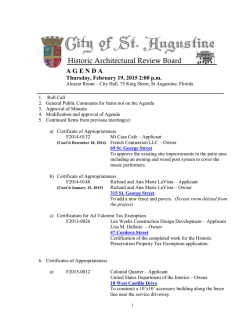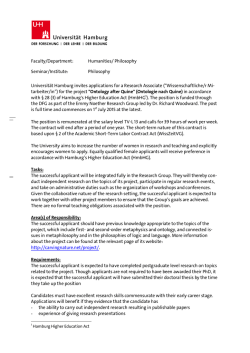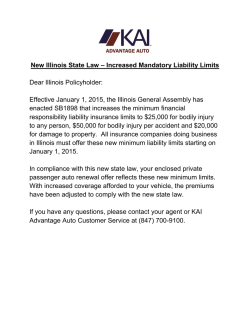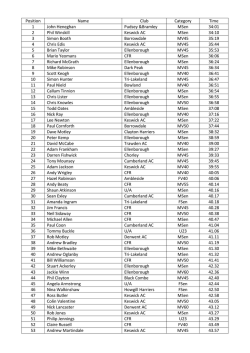
Standards for Environmental Reviews and Professionals
ILLINOIS HOUSING DEVELOPMENT AUTHORITY STANDARDS FOR ENVIRONMENTAL REVIEWS AND PROFESSIONALS January 2015 As part of the Application for Multifamily Financing, the Illinois Housing Development Authority (IHDA) requires applicants to secure Environmental Reviews (Phase I) from professional firms experienced in providing environmental reviews, and capable of producing the desired services in a professional, timely and cost-conscious manner. All applicants must submit a Phase I document (that includes the required forms) at the time of application. The Application must include two (2) copies of a Phase I Environmental Site Assessment (covering all Project Sites) completed within one (1) year prior to the Application deadline according to the Authority’s Standards for Environmental Reviews and Professionals available on the Website. The environmental firm selected by the applicant must meet the IHDA Standards for Environmental Reviews listed below, as well as the Supplemental Consultant Standards (attached as Appendix I). I. Scope of Services The environmental firm selected by the applicant must comply with ASTM Standard E1527-13 (Environmental Assessment Standards and Risk Management Standards): http://www.astm.org/Standards/E1527.htm (also found on the IHDA website), as well as be familiar with the standards for various types of environmental remediation, as described at http://www.astm.org/Standards/environmental-assessment-and-risk-management-standards.html. Also, all Phase I documents produced for IHDA-funded projects must include the “non-scope” items listed below under Section II, Format, with the proper backup documentation for each item as specified by the HUD OneCPD Environmental review website. The information below is intended as a guide for applicants to assist in the selection of environmental firms/professionals to be used on IHDA funded projects. It is the responsibility of the applicant to make his/her own determination regarding the capability, competence and/or limitations of a firm/professional. IHDA reserves the right to change or waive any of the requirements below and reject any submitted environmental assessment. II. Format (Phase I) All environmental documents/reports prepared for IHDA must follow the format specified in ASTM Standard E1527-13. Requests to alter the specified format should be directed to one of the individuals listed at the end of these guidelines. In addition to the ASTM requirements, the body of the Phase I ESA must address all of the items listed below by providing a professional opinion or recommendation as to the effect of the items below on the site, and indicate if additional research and/or testing is required. Even though some of the items are non-scope relative to the ASTM E1527-13 standards, they are still required to be addressed as a condition of IHDA funding. For ALL items, please refer to HUD’s OneCPD Environmental review site for specific guidelines regarding the precise backup documentation that is required by HUD for each topic. HUD’s ASTM fact sheet of changes to the ASTM E1527-13 standard is attached. EVERY topic must be addressed per HUD’s guidelines: https://www.onecpd.info/environmental-review. Additional assistance can be found at http://www.epa.gov/compliance/nepa/nepassist. 1 The Phase I MUST include the following HUD documents (Appendices 3-5 of this document): (1) Environmental Assessment for HUD-funded Proposals (2) Statutory Checklist (NOT the Statutory Worksheet) (3) Environmental Assessment Checklist ****IT IS MANDATORY THAT THE STATUTORY CHECKLIST AND ENVIRONMENTAL ASSESSMENT CHECKLIST INCLUDE ALL SOURCE DOCUMENTATION, REFERENCES, DATES, ETC. AS STATED IN THE INSTRUCTIONS ON THE RESPECTIVE FORM. ------------------------------------------------------------------------------------------------------------------------------------Color photographic documentation MUST be included for each relevant item; black and white photos are unacceptable. (1) Zoning: (a) What is the current zoning? (b) Will the project necessitate a change in zoning? (c) What are the project’s past and present land use(s)? (d) Is there any zoning change being considered that would impact this project? (2) Utilities: Describe the available utilities and/or easements. (3) Historic Preservation: Is the property/building listed in the Federal Register of Historic Places, located in a local historic district or have historic significance? Attach a map from HARGIS or equivalent (color map of the area with the site labeled clearly on the map, but only if HARGIS is unavailable). If “yes,” attach a map of local historic district or information on Federal Register listing. Be aware, if the area has not been properly surveyed, the developer will be responsible for completing all surveys required by the Illinois Historic Preservation Agency (IHPA). (4) Floodplain: Provide the flood zone designation. Attach a FEMA FIRM Map or a FIRMette of the area with the site located in outline (ie, not an arrow). The Application must include a Federal Emergency Management Agency (“FEMA”) floodplain map for the Project area with the boundaries of the Project site clearly delineated. FEMA floodplain maps can be obtained from the FEMA website. If any portion of the Project site is located within the 100 year floodplain or floodway, the Application must include one or both of the following as applicable: (a) Rehabilitation Projects proposing the rehabilitation of existing buildings must submit a site plan that clearly indicates all of the following: 1) The FEMA determined elevation of the floodplain or floodway; and 2) The elevation of the lowest floor level in the existing buildings; and 3) The location of the existing buildings. Note: Projects involving the rehabilitation of existing buildings on sites located in the 100-year floodplain or floodway will ONLY be permitted if the lowest existing floor elevation of each building in the floodplain is at least six (6) inches above the FEMA designated floodplain elevation. (b) New Construction Projects proposing new construction must submit a site plan that clearly indicates all of the following: 1) The FEMA determined elevation of the floodplain or floodway; and 2) The elevation of the lowest floor level in the proposed buildings; and 3) The location of the proposed buildings. In addition, the Application must include: 1) A FEMA Conditional Letter of Map Amendment (“CLOMA”) or FEMA Conditional Letter of Map Revision (“CLOMR”) for the Project site that shows the site is eligible for reclassification out of the floodplain; and 2) Evidence that the Project is eligible for flood insurance and that such insurance will be in place if awarded funding from the Authority until FEMA amends the flood plain map and the Authority determines the Project is no longer in the floodplain. 2 (5) Wetlands / Drainage: (a) Is the site location in or near a wetland? Is the site within the jurisdiction of the Army Corps of Engineers? Attach a color wetlands map. (b) Does water accumulate on or near the site or does water run through or near to the site in the form of a creek or stream at any time during the year? Are any types of hydrophilic plants present? (c) Does the project impact or is it located near a drainage way (creek or stream bed) of a water shed that drains an area of more than one square mile? If applicable, a drainage permit from the Illinois Department of Natural Resources will be required before construction can begin. (d) Is the site on or near a drainage way of a water shed that drains an area of more than one square mile? (6) Noise: (a) Is the project site located within 3,000 feet of a railroad? If “yes”: provide the name and address of the railroad company, contact person, and telephone number. (b) Is site located within 1,000 feet of a major road, highway, or freeway? If “yes”: name road(s). (c) Is the project site located within 15 miles of a military airport or within five miles of a commercial airport with scheduled air service? If “yes”: provide the name and address of the airport, contact person, and telephone number; also, if “yes,” is the site in an airport clear zone? (d) Is the project site located near (one mile radius) of any other noise generating source (e.g. industrial plant)? If “yes”: provide the name and address of company, contact person, and telephone number. Also, if “yes” to any of the above, an additional noise survey or assessment is required in compliance with 24CFR 51, subpart B. (e) If the answer to any of the above is “yes,” calculate the decibel levels for the project using the DNL Calculator at HUD’s site: http://portal.hud.gov/hudportal/HUD?src=/program_offices/comm_planning/environment/dnlcalculator (7) Hazards: (a) UST/AST: Is the project site located near or in an area where conventional petroleum fuels (e.g., gasoline), other hazardous liquids or gases, chemicals of a flammable nature (e.g., benzene or hexane) or any other potentially hazardous materials are stored in a structure, an above-ground storage tank or an under-ground storage tank? What is the geology of the area? Are unconsolidated soils present? Will the geology of the area (ie, porosity and permeability of the soils) impact migration of hazardous substances? (b) PCBs: Is the project site located near or in an area where gas pipelines, electrical transmission lines, electrical towers or electrical sub-stations are located? (c) Asbestos: Is there any evidence of asbestos-containing materials at the site? Indicate location(s) and extent of affected readily accessible areas. (d) Lead: Is there any evidence of lead-based paint at the site? Indicate location(s) and extent of affected readily accessible areas. (e) Mercury and other heavy metals: Is there any evidence of mercury (e.g., old thermostats) or other heavy metals at the site? Indicate location(s) and extent of affected readily accessible areas. (f) Seismic: Provide the seismic zone information. Are there any natural hazards located on, adjacent to, or nearby the site, such as steep slopes, geologic faults, or hazardous terrain features? (g) Mining: Is the project located near a mine or is the property located in a county affected by mining? Locate the project using the ISGS Coal Mines in Illinois Viewer at http://www.isgs.illinois.edu/ilmines. (h) Mold: Is there any evidence of mold? Indicate location(s) and extent of affected readily accessible areas. (i) Radon: Is there evidence of elevated radon levels? Indicate the radon zone for the site according to the EPA. Plans may need to show evidence of a passive/future active venting system. (j) Vapor Intrusion: Have volatile chemicals migrated into the structure in gaseous form? 3 (8) Other Hazards: (a) Is the project site located on or near a waste dump or landfill site? (b) Is the project site near an industry which disposes of chemicals or hazardous wastes on its own premises? (c) Are barrels, drums and/or other containers of potentially hazardous chemicals present on the site? (d) Is the project site located in an airport clear zone? (9) Other Environmental Issues: (a) Endangered and Threatened Species: Does the project affect federally-listed or -proposed threatened and endangered species, or designated or proposed critical habitats? Provide a letter or other documentation from US Fish and Wildlife Service (website determination/screen shot of “no impact” is sufficient), and an evaluation based on the EcoCAT website. (b) Environmental Justice: Is there any reason to suspect that Environmental Justice could be an issue at or near this site (c) Coastal Zone: Is the site located within the Coastal Zone? (d) Sole Source Aquifer: Is the site located within an area designated as being supported by a sole source aquifer? (e) Farmland: Is the site or area presently being farmed, forested, or being used as croplands? How does this relate to the current zoning of the site? (f) Unique Natural Features: Is the site near unique natural features (i.e., bluffs or cliffs) or near public or private scenic areas? (g) Clean Air Act: How will the project impact air quality as described by the Clean Air Act? (h) Tribal Interest: Section 106 of the National Historic Preservation Act of 1966 (16 USC 470f) requires consultation with federally-recognized Native American tribes when a project may affect a traditional religious or cultural property of significance to the tribe. Tribal interest in a particular county can be found by using the Tribal Directory Assessment Tool (TDAT) on HUD’s site: http://egis.hud.gov/tdat/Tribal.aspx A sample letter to facilitate outreach to potentially interested tribes is attached as Appendix 2. Neither the environmental firm nor the environmental professional/Phase I consultant is released from identifying additional potential environmental issues on the property by addressing the items above. Additionally, IHDA must be explicitly addressed as being able to rely on the Phase I. III. Format (Phase II) Occasionally, IHDA will require a more detailed review of one or more aspects of the project be submitted. This is a Phase II or a Limited Phase II. Such documents must follow the format and style established in ASTM Standard E1903-11. IV. Professional Qualifications Per the National Archives and Records Administration Electronic Code of Federal Regulations, Subpart B -- Definitions and References, an Environmental Professional is defined as (Section 312.10): (1) a person who possesses sufficient specific education, training, and experience necessary to exercise professional judgment to develop opinions and conclusions regarding conditions indicative of releases or threatened releases (see §312.1(c)) on, at, in, or to a property, sufficient to meet the objectives and performance factors in §312.20(e) and (f). (2) Such a person must: (a) Hold a current Professional Engineer's or Professional Geologist's license or registration from a state, tribe, or U.S. territory (or the Commonwealth of Puerto Rico) and have the equivalent of three (3) years of full-time relevant experience; or 4 (b) Be licensed or certified by the federal government, a state, tribe, or U.S. territory (or the Commonwealth of Puerto Rico) to perform environmental inquiries as defined in §312.21 and have the equivalent of three (3) years of full-time relevant experience; or (c) Have a Baccalaureate or higher degree from an accredited institution of higher education in a discipline of engineering or science and the equivalent of five (5) years of full-time relevant experience; or (d) Have the equivalent of ten (10) years of full-time relevant experience. (3) An environmental professional should remain current in his or her field through participation in continuing education or other activities. (4) The definition of environmental professional provided above does not preempt state professional licensing or registration requirements such as those for a professional geologist, engineer, or site remediation professional. Before commencing work, a person should determine the applicability of state professional licensing or registration laws to the activities to be undertaken as part of the inquiry identified in §312.21(b). (5) A person who does not qualify as an environmental professional under the foregoing definition may assist in the conduct of all appropriate inquiries in accordance with this part if such person is under the supervision or responsible charge of a person meeting the definition of an environmental professional provided above when conducting such activities. Relevant experience, as used in the definition of environmental professional in this section, means: participation in the performance of all appropriate inquiries investigations, environmental site assessments, or other site investigations that may include environmental analyses, investigations, and remediation which involve the understanding of surface and subsurface environmental conditions and the processes used to evaluate these conditions and for which professional judgment was used to develop opinions regarding conditions indicative of releases or threatened releases (see §312.1(c)) to the subject property. V. Ethics The Code of Ethics and Standards of Practice for Environmental Professionals from the National Association of Environmental Professionals shall apply to all individuals providing environmental services for IHDA projects. The Code can be found at http://www.naep.org/code-of-ethics. VI. Fee Basis Fees for all cost and expenses related to the performance of the scope of services shall be determined between the firm and the applicant. The applicant is responsible for payment of fees and entering into a written agreement with the selected firm. Kickbacks or incentives for procuring inflated values will not be permitted. IHDA shall review the environmental assessment/Phase I fees associated with the development to insure they are proper, fair and reasonable. IHDA has evaluated the fees from past IHDA-financed projects, and offers the following maxima for each type of service (please be aware that IHDA recommends quoting fees that are no more than 75% of these maxima, unless justified in a written narrative): Phase I (including all non-scope items listed above): Phase II (single subject, exclusive of topics below): Asbestos Study: Lead Study: Noise Study: Soils Study (including Subsurface Sampling Update letter: Updated Phase I: VII. Questions 5 $10000 $4000 $4000 $500/unit, not to exceed $4000 $4000 $10000 $2500 $5000 Any questions or request for clarification regarding this service must be submitted to Jennifer Pack, Manager, Architecture and Construction Services at (312) 836-5355 or [email protected] or Ana Asilis, Staff Architect, Multifamily Financing Department at (312) 836-5369 or [email protected]. Appendix 1 ILLINOIS HOUSING DEVELOPMENT AUTHORITY SUPPLEMENTAL PROFESSIONAL SERVICES FIRM REQUIRMENTS August 2012 As part of the Application for Multifamily Financing, the Illinois Housing Development Authority (IHDA) requires applicants to secure studies from professional services firms experienced in providing cost estimating services, market studies, Phase I Environmental studies, Rent Comparability Studies, and Property Needs Assessments. The professional services firms selected by the applicant must meet the Supplemental Consultant standards listed below along with the standards for each discipline as found on the IHDA website. The information below is intended as a guide to applicants in the selection of consultants to be used on IHDA funded projects. It is the responsibility of the applicant to make his/her own determination regarding the capability, competence and/or limitations of a consultant. IHDA reserves the right to change or waive any of the requirements below and reject any studies. I. Minimum Qualifications Professional services firms selected and retained by applicants must be registered with the Illinois Department of Revenue to conduct business in Illinois and not be debarred, suspended or otherwise prohibited from professional practice by any Federal, State or Local Agency. The selected firm is required to have been in business for a minimum of five (5) years and must demonstrate knowledge and related experiences with regard to preparation of studies for affordable housing projects using federal, state and city funds. The professional services firm must supply the applicant with documentation of the firm’s professional qualifications, including: Illinois Department of Revenue registration, resumes of key members assigned to the project demonstrating a minimum of ten (10) years’ experience in the design, development and/or construction of affordable housing. II. Minority Procurement Efforts 6 The applicant is required to make a proactive effort in selecting and retaining qualified firms certified as Minority Business Enterprise (MBE), Disadvantaged Business Enterprise (DBEs) and Women Business Enterprise (WBEs) whenever possible. The applicant is required to verify any selected MBEs, MBEs and WBEs are registered and have a valid certification number. III. References The selected firm must supply the applicant at least three (3) professional references pertaining to the firm’s experience in performing consultant services for projects of a similar type, scale, and complexity. IV. Fee Basis Fees for all cost and expenses related to the performance of the scope of services shall be determined between the professional services firm and the applicant. The applicant is responsible for payment of fees and entering into a written agreement with the selected professional services firm. Kickbacks or incentives for procuring inflated values will not be permitted. IHDA shall review the fees associated with the development to insure they are proper, fair and reasonable. IHDA has evaluated the fees from past IHDA financed projects. As such, the fees listed in each specific consultant standard reflect the maximum percentage IHDA will accept as a reasonable fee for services. Higher fee are acceptable but the owner/developer will be responsible to pay the difference between the higher fees and the fees indicated in the individual consultant standards. V. Insurance The selected firm must supply the applicant with proof of Professional Liability insurance with a policy limit of $1,000,000 per occurrence and $2,000,000 excess umbrella and must submit a copy of the certificate to IHDA. The applicant will determine and notify the applicant of any additional parties, if required prior to contract issuance. Selected firms must not allow their liability insurance to expire or cancel for any reason during the contract period. VI. Conflict of Interests Professional firms selected to perform services shall not have any direct or indirect interest in any property to be evaluated. IHDA reserves the right to determine necessary actions to eliminate or neutralize any conflict discovered after an applicant secured a professional firm to provide this service. The professional services firm shall certify that no undue pressure or collusion with the client or their representatives exists in the determination of the study. The study certification shall also state that all information and procedures used to establish the study were from factual data and prepared in a professional manor. The study must include a statement from the individual signing the study that there is no identity of interest between the signatory and any member of the development team. If any member of the development team or ownership has an identity of interest with the entity providing the study, the identity of interest relationship must be disclosed. Failure to disclose any organizational conflict of interest may result in rejection of the application and/or the study by the professional firm with the conflict and request of a study from a different firm at applicant’s expense. 7 8 9 Appendix 2 [Name of Tribe or Tribal Venue] ATTN: [Tribal Contact Name] [Mailing Address] [City, State, Zip] SUBJECT: Disposition of [type of property] in [city, state]. Our office is trying to gather information with regard to the historical significance of the subject sites. We are requesting your organization provide any information of historical importance that relates to [this/these site(s)]. The following provides a description of the subject project to assist you with your review. I. SUBJECT PROJECT ____ property sale ____ new construction ____ property conversion ____ minor ground disturbance ____ refinancing ____ minor repairs ____ minor rehabilitation ____ major rehabilitation ____ demolition ____ leasing Size or Scale of Project: [units, #floors, acreage, #buildings, etc.] Project Involves: ____ scattered sites ____ an existing neighborhood ____ a few adjacent properties ____ a commercial/industrial area ____ a single property ____ a central business district ____ a city block ____ a known historic property ____ several city blocks ____ a new subdivision ____ development in an undeveloped area ____ a unique facility (seaport, depot, theater, hotel) Narrative Description: The Illinois Housing Development Authority would like to finance the development of the above site(s) in the [city] area. The project is listed on the attached documents/ maps. The scope exceeds what is allowed by the 24 CFR Part 50 “Categorical Exclusion” requirements; therefore, this project requires a full Environmental Assessment. 10 Our [date of visit] site survey confirms there is no known direct impact on any historical sites; however, we would appreciate a response to this letter if you do not concur. We did not locate any historically significant properties in the vicinity of the project. Although [city] does have some distinctive architecture and historical significance, this project is not perceived to be in those categories. We were unable to identify any Environmental Impact on or adjacent to the project, and we suspect the project will be of little interest to Tribal issues. Photographs and additional information on the project are available upon request. II. LEGAL DESCRIPTION OF PROJECT AREA IS ATTACHED ( ) Yes ( ) No PHOTOGRAPH OF SITE IS ATTACHED (Available upon request if not attached) ( ( ) No ) Yes Tribal Organization Review: Historical Significance: ( ) Yes (explain below; attach additional pages if needed) ( ) No _______________________________________________________________________________ ______________________________________________________________________________ ______________________________________________________________________________ We are requesting a response to this request within 30 days of the date of this letter. Should no response be received by the end of the 30 day time frame, we will proceed with the project and note your organization as having no interest. Should you have any questions concerning this project, feel free to contact [insert name] at [insert complete phone number and email]. Sincerely, [Name and Title] [Environmental Firm or Agency] Enclosure: Legal Description 11 Appendix 3 Environmental Assessment for HUD-funded Proposals Recommended format per 24 CFR 58.36 Project Identification: Preparer: Responsible Entity: Month/Year: 12 Environmental Assessment Responsible Entity: ___________________________________________________________ [24 CFR 58.2(a)(7)] Certifying Officer: _____________________________________________________________ [24 CFR 58.2(a)(2)] Project Name: ________________________________________________________________ Project Location: ______________________________________________________________ ______________________________________________________________________ _______ Estimated total project cost: ____________________________________________________ Grant Recipient: _____________________________________________________________ [24 CFR 58.2(a)(5)] Recipient Address: ____________________________________________________________ ______________________________________________________________________ _______ Project Representative: ________________________________________________________ Telephone Number: ___________________________________________________________ Conditions for Approval: (List all mitigation measures adopted by the responsible entity to eliminate or minimize adverse environmental impacts. These conditions must be included in project contracts and other relevant documents as requirements). [24 CFR 58.40(d), 40 CFR 1505.2(c)] 13 FINDING: [58.40(g)] ___ Finding of No Significant Impact (The project will not result in a significant impact on the quality of the human environment) ___ Finding of Significant Impact (The project may significantly affect the quality of the human environment) Preparer Signature: ______________________________________________Date:________ Name/Title/Agency:_____________________________________________________ ______ RE Approving Official Signature: ___________________________________Date:________ Name/Title/ Agency:____________________________________________________________ 14 Statement of Purpose and Need for the Proposal: [40 CFR 1508.9(b)] Description of the Proposal: Include all contemplated actions which logically are either geographically or functionally a composite part of the project, regardless of the source of funding. [24 CFR 58.32, 40 CFR 1508.25] Existing Conditions and Trends: Describe the existing conditions of the project area and its surroundings, and trends likely to continue in the absence of the project. [24 CFR 58.40(a)] 15 Appendix 4 Statutory Checklist [24CFR §58.5] Record the determinations made regarding each listed statute, executive order or regulation. Provide appropriate source documentation. [Note reviews or consultations completed as well as any applicable permits or approvals obtained or required. Note dates of contact or page references]. Provide compliance or consistency documentation. Attach additional material as appropriate. Note conditions, attenuation or mitigation measures required. Factors Historic Preservation Determination and Compliance Documentation [36 CFR 800] Floodplain Management [24 CFR 55, Executive Order 11988] Wetlands Protection [Executive Order 11990] Coastal Zone Management Act [Sections 307(c),(d)] Sole Source Aquifers [40 CFR 149] Endangered Species Act [50 CFR 402] Wild and Scenic Rivers Act [Sections 7 (b), (c)] Air Quality [Clean Air Act, Sections 176 (c) and (d), and 40 CFR 6, 51, 93] Farmland Protection Policy Act [7 CFR 658] Environmental Justice [Executive Order 12898] HUD Environmental Standards Determination and Compliance Documentation Noise Abatement and Control [24 CFR 51 B] Toxic/Hazardous/Radioa ctive Materials, Contamination, Chemicals or Gases 16 [24 CFR 58.5(i)(2)] Siting of HUD-Assisted Projects near Hazardous Operations [24 CFR 51 C] Airport Clear Zones and Accident Potential Zones [24 CFR 51 D] 17 Appendix 5 Environmental Assessment Checklist [Environmental Review Guide HUD CPD 782, 24 CFR 58.40; Ref. 40 CFR 1508.8 &1508.27] Evaluate the significance of the effects of the proposal on the character, features and resources of the project area. Enter relevant base data and verifiable source documentation to support the finding. Then enter the appropriate impact code from the following list to make a determination of impact. Impact Codes: (1) - No impact anticipated; (2) - Potentially beneficial; (3) - Potentially adverse; (4) - Requires mitigation; (5) - Requires project modification. Note names, dates of contact, telephone numbers and page references. Attach additional material as appropriate. Note conditions or mitigation measures required. Land Development Code Source or Documentation Conformance with Comprehensive Plans and Zoning Compatibility and Urban Impact Slope Erosion Soil Suitability Hazards and Nuisances including Site Safety Energy Consumption Noise - Contribution to Community Noise Levels Air Quality Effects of Ambient Air Quality on Project and Contribution to Community Pollution Levels Environmental Design Visual Quality - Coherence, Diversity, Compatible Use and Scale Socioeconomic Code Source or Documentation Code Source or Documentation Demographic Character Changes Displacement Employment and Income Patterns Community Facilities and Services Educational Facilities 18 Commercial Facilities Health Care Social Services Solid Waste Waste Water Storm Water Water Supply Public Safety - Police - Fire - Emergency Medical Open Space and Recreation - Open Space - Recreation - Cultural Facilities Transportation Natural Features Source or Documentation Water Resources Surface Water Unique Natural Features and Agricultural Lands Vegetation and Wildlife 19 Other Factors Source or Documentation Flood Disaster Protection Act [Flood Insurance] [§58.6(a)] Coastal Barrier Resources Act/ Coastal Barrier Improvement Act [§58.6(c)] Airport Runway Clear Zone or Clear Zone Disclosure [§58.6(d)] Energy Consumption (HUD Energy Action Plan) Summary of Findings and Conclusions ALTERNATIVES TO THE PROPOSED ACTION Alternatives and Project Modifications Considered [24 CFR 58.40(e), Ref. 40 CFR 1508.9] (Identify other reasonable courses of action that were considered and not selected, such as other sites, design modifications, or other uses of the subject site. Describe the benefits and adverse impacts to the human environment of each alternative and the reasons for rejecting it.) No Action Alternative [24 CFR 58.40(e)] (Discuss the benefits and adverse impacts to the human environment of not implementing the preferred alternative). Mitigation Measures Recommended [24 CFR 58.40(d), 40 CFR 1508.20] (Recommend feasible ways in which the proposal or its external factors should be modified in order to minimize adverse environmental impacts and restore or enhance environmental quality.) Additional Studies Performed (Attach studies or summaries) List of Sources, Agencies and Persons Consulted [40 CFR 1508.9(b)] 20
© Copyright 2025





